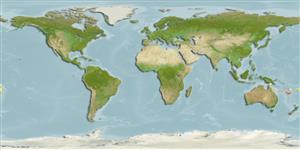Teleostei (teleosts) >
Blenniiformes (Blennies) >
Tripterygiidae (Triplefin blennies) > Tripterygiinae
Etymology: Enneapterygius: Greek, ennea = nine times + Greek, pterygion = little fin (Ref. 45335).
More on author: Fricke.
Environment: milieu / climate zone / depth range / distribution range
Ecology
Marine; reef-associated; depth range 2 - 4 m (Ref. 13227). Tropical
Western Central Pacific: known only from the Baie de St. Vincent, New Caledonia.
Size / Weight / Age
Maturity: Lm ? range ? - ? cm
Max length : 3.3 cm SL male/unsexed; (Ref. 54980)
Short description
Identification keys | Morphology | Morphometrics
Dorsal spines (total): 16; Dorsal soft rays (total): 8 - 9; Anal spines: 1; Anal soft rays: 20. Short supraorbital tentacle; first dorsal-fin 25% shorter than second dorsal fin; male coloration whitish with fine specks of black dots, darkening on area of opercle; rough reticular pattern of deep reddish brown on body; base of pectoral fin bearing a broad, dark reddish brown bar; anal fin and first 2 dorsal fins dusky colored with weak red rays; transparent caudal fin bearing a reddish white bar at its base, proximal end with vertically aligned reddish dots. Dorsal rays III + XIII + 8-9; lateral line interrupted, 17-18 + 20-21; mandibular pores 5 + 2 + 5 (Ref. 54980).
Eggs are hemispherical and covered with numerous sticky threads that anchor them in the algae on the nesting sites (Ref. 240). Larvae are planktonic which occur primarily in shallow, nearshore waters (Ref. 94114).
Life cycle and mating behavior
Maturities | Reproduction | Spawnings | Egg(s) | Fecundities | Larvae
Fricke, R., 1994. Tripterygiid fishes of Australia, New Zealand and the southwest Pacific Ocean (Teleostei). Theses Zool. 24:1-585. (Ref. 13227)
IUCN Red List Status (Ref. 130435)
Threat to humans
Harmless
Human uses
Fisheries: of no interest
Tools
Special reports
Download XML
Internet sources
Estimates based on models
Preferred temperature (Ref.
123201): 24.7 - 28, mean 26.4 °C (based on 225 cells).
Phylogenetic diversity index (Ref.
82804): PD
50 = 0.5000 [Uniqueness, from 0.5 = low to 2.0 = high].
Bayesian length-weight: a=0.00562 (0.00258 - 0.01228), b=3.08 (2.89 - 3.27), in cm total length, based on LWR estimates for this (Sub)family-body shape (Ref.
93245).
Trophic level (Ref.
69278): 3.1 ±0.3 se; based on size and trophs of closest relatives
Resilience (Ref.
120179): High, minimum population doubling time less than 15 months (Preliminary K or Fecundity.).
Fishing Vulnerability (Ref.
59153): Low vulnerability (10 of 100).
